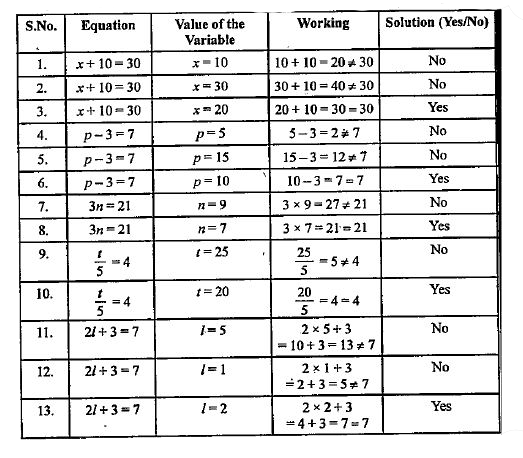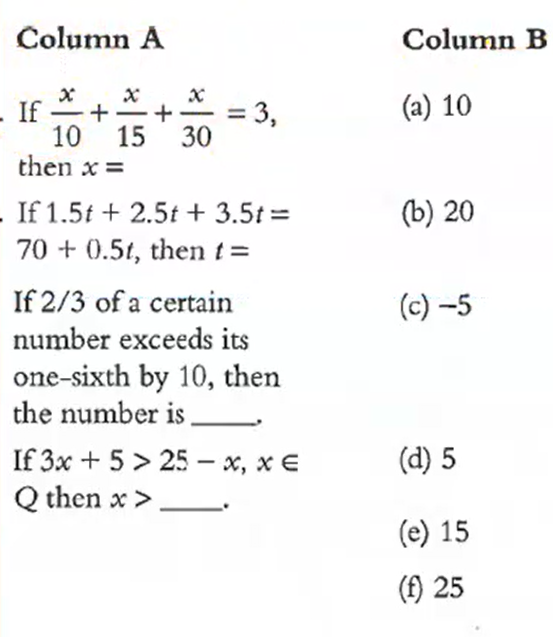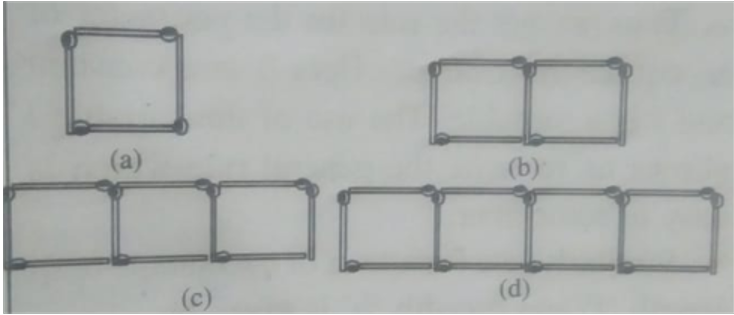Look at the match sticks patterns of squares. The squares are not separate. Two neighbouring square have a common match stick. Observe the patterns and find the rule take gives the number of match sticks in term of numbr of squares.
 Solution in Punjabi
Solution in Punjabi
Step by step video & image solution for Look at the match sticks patterns of squares. The squares are not separate. Two neighbouring square have a common match stick. Observe the patterns and find the rule take gives the number of match sticks in term of numbr of squares. by Maths experts to help you in doubts & scoring excellent marks in Class 6 exams.
Updated on:21/07/2023Topper's Solved these Questions
- ALGEBRABOOK - NAND LAL PUBLICATIONCHAPTER - ALGEBRAEXERCISE - EXERCISE-11.2
13 Videos
- ALGEBRABOOK - NAND LAL PUBLICATIONCHAPTER - ALGEBRAEXERCISE - EXERCISE - 11.3
37 Videos
- ALGEBRABOOK - NAND LAL PUBLICATIONCHAPTER - ALGEBRAEXERCISE - SOLUTION OF TEXTUAL QUESTIONS (Page-239)
1 Video
- BASIC GEOMETRICAL IDEAS BOOK - NAND LAL PUBLICATIONCHAPTER - BASIC GEOMETRICAL IDEAS EXERCISE - SAMPLE PAPER FOR PRACTICE
18 Videos
Similar Questions
The side of an equilateral triangle is shown by x. Express the perimeter of the equilateral triangle using x.
View SolutionMake up as many expressions with numbers (no variables) as you can, from three numbers 2, 3 and 5. Every number should be used not more than once. Use only addition, subtraction and multiplication.
Make the other expressions.
2×(5−3)
View SolutionComplete the entries in the following table and explain why your answer is Yes/No.

View SolutionIf lines l and m intersect at a point Also m and n intersect at a point, is it necessary that lines l,m,n intersect at the same point.
View Solution(a) Look at the following matchstick pattern of squares (Fig 11.6). The squares are not separate. Two neighbouring squares have a common matchstick. Observe the patterns and find the rule that gives the number of matchsticks in terms of the number of squares. (Hint : If you remove the vertical stick at the end, you will get a pattern of Cs.)(b) Fig 11.7 gives a matchstick pattern of triangles. As in Exercise 11 (a) above, find the general rule that gives the number of matchsticks in terms of the number of triangles.

View SolutionMatch the following Column A to Column B

View SolutionWhat is the distance OA for the square shown in figure :- ltimg src="https://d10lpgp6xz60nq.cloudfront.net/physics_images/ALN_PHY_R05_E01_015_Q01.png" width="80%"gt
View SolutionMatch the followings (column I with column II)
ltimg src="https://d10lpgp6xz60nq.cloudfront.net/physics_images/NCERT_BIO_XI_C03_E01_011_Q01.png" width="80%"gt
View SolutionMatch column I with column II:
ltimg src="https://d10lpgp6xz60nq.cloudfront.net/physics_images/NCERT_BIO_XI_C18_E01_003_Q01.png" width="80%"gt
View Solution(a) Look at the following matchstick pattern of squares (Fig 11.6). The squares are not separate. Two neighbouring squares have a common matchstick. Observe the patterns and find the rule that gives the number of matchsticks in terms of the number of squares. (Hint : If you remove the vertical stick at the end, you will get a pattern of Cs.)(b) Fig 11.7 gives a matchstick pattern of triangles. As in Exercise 11 (a) above, find the general rule that gives the number of matchsticks in terms of the number of triangles.
View Solution(a)Look at the following matchstick pattern of squares (Fig 11.6). The squares are not separate. Two neighbouring squares have a common matchstick. Observe the patterns and find the rule that gives the number of matchsticks in terms of the number of squares. (Hint: If you remove the vertical stick at the end, you will get a pattern of Cs.)
View Solution(a)Look at the following matchstick pattern of squares (Fig 11.6). The squares are not separate. Two neighbouring squares have a common matchstick. Observe the patterns and find the rule that gives the number of matchsticks in terms of the number of squares. (Hint: If you remove the vertical stick at the end, you will get a pattern of Cs.)(c)
View Solution(a)Look at the following matchstick pattern of squares (Fig 11.6). The squares are not separate. Two neighbouring squares have a common matchstick. Observe the patterns and find the rule that gives the number of matchsticks in terms of the number of squares. (Hint: If you remove the vertical stick at the end, you will get a pattern of Cs.)(d)
View SolutionLook at the following matchstick pattern of squares. The squares are not separate. Two neighboring squares have a common matchstick. Observe the patterns and find the rule that gives the number of matchsticks in terms of the number of squares. (Hint: If you remove the vertical stick at the end, you will get a pattern of Cs.)
View SolutionLook at the following matchstick pattern of squares. The squares are not separate. Two neighboring squares have a common matchstick. Observe the patterns and find the rule that gives the number of matchsticks in terms of the number of squares. (Hint: If you remove the vertical stick at the end, you will get a pattern of Cs.)
 .
.
View Solution